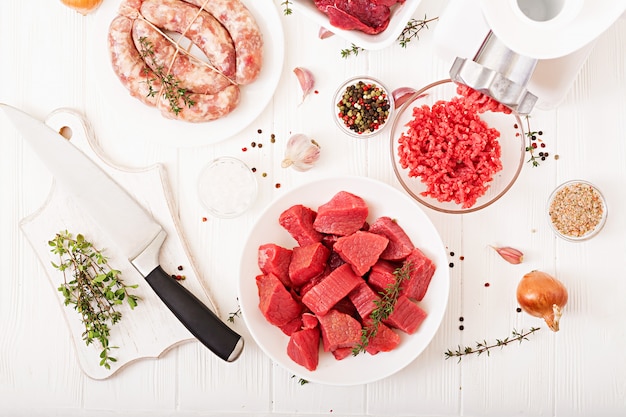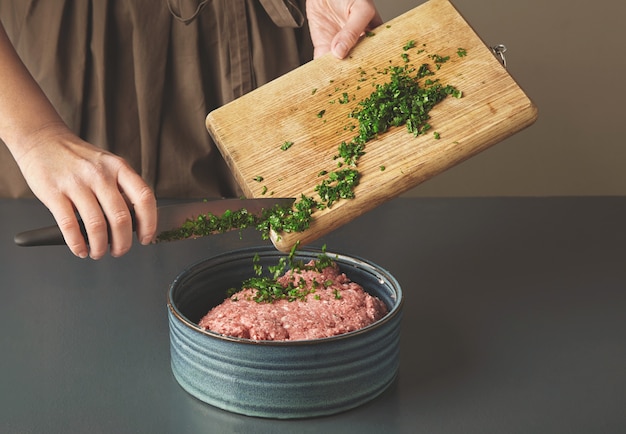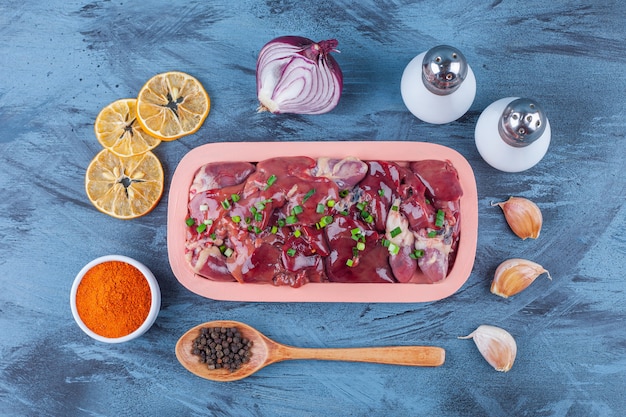Imagine this: You’re facing a culinary dilemma, staring into the abyss of your freezer, a rumbling tummy demanding sustenance. You spot a tempting slab of frozen meat, the perfect solution to your hunger pangs. But then the nagging question arises: "Can I just throw this straight into the pan and call it a day?"
For years, I've navigated this very question, experiencing a mix of culinary successes and a few close calls. I've learned that cooking frozen meat isn't a simple matter of throwing it in a pan and hoping for the best. There are some essential safety measures, cooking techniques, and insider tips you need to know to ensure a delicious and safe meal. So, let's delve into the fascinating world of frozen meat, debunk some myths, and equip you with the knowledge you need to cook frozen meat confidently and with a smile.
Part 1: The Safety Concerns – Why We Need to Be Cautious

Cooking frozen meat presents a unique set of challenges, primarily due to the presence of bacteria that thrive in cold environments. These bacteria, often lurking within the meat's icy depths, can pose a health risk if not dealt with properly.
1.1. The Bacteria Factor: Ice-Cold Microbe Haven
Think of frozen meat as a bacteria's cozy winter haven. While freezing slows down their growth, it doesn't eliminate them altogether. When you cook frozen meat, these bacteria have a longer time to potentially multiply due to the extra time needed to heat the meat to a safe temperature. The danger lies in undercooked meat, which allows those lurking bacteria a chance to party – a situation we definitely want to avoid.
1.2. The Undercooked Dilemma: A Balancing Act of Browning and Safety
Achieving that glorious golden-brown crust on your steak is a culinary goal, but it's easy to get carried away and neglect the meat's interior when working with frozen meat. The challenge lies in ensuring the outside cooks quickly while the core reaches a safe internal temperature. undercooked meat not only poses a health risk but can also result in a less-than-ideal flavor profile, leaving you with a chewy texture and a less-than-desirable dining experience.
Part 2: The Dos and Don'ts – Guiding Your Frozen Meat Journey

Don't be intimidated by the safety concerns! With the right approach, cooking frozen meat can be a delicious and rewarding experience. Here's a roadmap of dos and don'ts to help you navigate your frozen meat adventures.
2.1. The Dos – Embracing Safety and Efficiency
- Use a meat thermometer: This is your culinary compass, especially when dealing with frozen meat. Don't rely on visual cues like color; a good meat thermometer provides precise readings, ensuring your meat reaches a safe internal temperature. I highly recommend investing in a high-quality meat thermometer – it's a worthwhile investment that will provide peace of mind and elevate your cooking.
- Cook It Thoroughly: There's no room for compromise here. Always cook meat to the recommended safe internal temperature. For poultry, it's 165°F (74°C). For beef, pork, and lamb, it's 145°F (63°C). Be persistent! Check the temperature multiple times during the cooking process to ensure even cooking. Remember, it's better to be safe than sorry!
- Cut It Up: Break down large frozen meat chunks into smaller pieces. This allows the heat to penetrate more evenly, reducing the risk of undercooked areas. Think of it as giving your meat a helping hand.
- Increase the cooking time: Frozen meat requires more time to cook than thawed meat. Don't be afraid to increase the cooking time specified in your recipe. It's better to err on the side of caution, ensuring the meat reaches a safe temperature.
- Stir and Flip: Regularly stir or flip your meat during cooking. This promotes even heat distribution, preventing cold spots and ensuring thorough cooking. Think of it as a culinary dance between heat and meat.
2.2. The Don'ts – Avoiding Culinary Mishaps
- Don't Overcrowd the Pan: This is a recipe for disaster. Give your meat some breathing room. Overcrowding traps steam, leading to uneven cooking. Remember, a crowded pan is like a dance floor with too many dancers – nobody can move, and things get messy!
- Don't Microwave It: Microwaving frozen meat might seem like a quick fix, but it's not the safest option. Uneven heating can result in cold spots and undercooked areas, where bacteria might survive. Plus, microwaving often leaves meat tough and chewy, far from ideal. Resist the temptation!
- Don't Refreeze It: Once you've thawed meat, don't refreeze it. The thawing process encourages bacteria growth, and refreezing won't eliminate those pesky microbes. If you're not cooking the meat immediately, store it in the refrigerator. Think of it as a one-way street for thawing – thawed meat is best enjoyed fresh!
Part 3: Different Methods for Cooking Frozen Meat – Choosing the Right Approach

Armed with the safety knowledge, let's explore various cooking methods for frozen meat. Each method presents its own set of advantages and considerations.
3.1. Oven: A Slow and Steady Heat
The oven provides even heat distribution, making it a great option for cooking large frozen meat cuts. Roast, bake, or even grill frozen meat in your oven, giving it ample time to reach a safe internal temperature.
3.1.1. Tips for Oven Cooking Frozen Meat:
- Preheat Your Oven: This allows for faster and more even cooking. It's like giving your meat a warm welcome!
- Use a Baking Sheet: This prevents sticking and ensures easy cleanup. It's a simple yet effective trick.
- Cover the Meat: Covering the meat with foil helps retain moisture and promotes even cooking. Think of it as a comforting blanket for your meat.
3.2. Stovetop: Mastering the Art of High Heat
The stovetop requires a bit more attention and control, but it can be a good option if you're short on time. Pan-frying or stir-frying frozen meat works well, as the high heat helps cook the meat quickly.
3.2.1. Tips for Stovetop Cooking Frozen Meat:
- Use a Heavy Pan: This promotes even heat distribution and prevents sticking. It's like having a sturdy foundation for your culinary creation.
- Don't Overcrowd the Pan: Give your meat space to breathe and cook evenly. Remember, a crowded pan can lead to a steaming mess and uneven cooking.
- Use a Meat Thermometer: This is crucial for verifying that the meat has reached a safe internal temperature.
3.3. slow cooker: The Ultimate Hands-Off Approach
The slow cooker is your culinary ally if you're looking for a convenient and hands-off cooking method. It's ideal for frozen meat because it cooks slowly and evenly. Simply toss your frozen meat into the slow cooker, add liquid, and let it simmer for hours. I love using the slow cooker for pulled pork, transforming a frozen pork shoulder into delicious sandwiches. It's effortless and delicious!
3.3.1. Tips for Slow Cooker Cooking Frozen Meat:
- Cook on Low: Slow and low cooking is the secret to success with frozen meat in the slow cooker. It ensures thorough cooking without drying out the meat.
- Add Liquid: The frozen meat will release some liquid as it cooks, but adding extra liquid will help prevent dryness. Think of it as a hydrating bath for your meat.
3.4. Air Fryer: Crisp, Quick, and Easy
The air fryer, a relatively recent kitchen gadget, has revolutionized cooking frozen meat. It uses hot air circulation to cook food quickly and evenly, resulting in crispy, delicious results in a fraction of the time. I can't get over how quickly I can make crispy chicken tenders in the air fryer – it's a game-changer!
3.4.1. Tips for air fryer cooking Frozen Meat:
- Preheat the Air Fryer: This allows for faster and more even cooking. Get that air fryer ready to party!
- Don't Overcrowd the Basket: Give your meat space to cook properly. A crowded basket can hinder air circulation and result in uneven cooking.
- Shake the Basket: During cooking, shake the basket a few times to promote even heat distribution and crispy results. It's like giving your meat a little dance move!
Part 4: Understanding food safety – Protecting Your Kitchen and Health
Now let's delve into the essential food safety principles that govern our frozen meat adventures. While cooking techniques are crucial, understanding food safety is paramount for creating a safe and enjoyable culinary experience.
4.1. The Danger Zone: Where Bacteria Thrive
The danger zone, that temperature range between 40°F (4°C) and 140°F (60°C), is where bacteria multiply rapidly. We need to ensure our meat doesn't spend too much time in this zone. For thawing, keep meat in the refrigerator, below 40°F, where bacteria growth is significantly slowed. After cooking, promptly refrigerate cooked meat, not letting it sit out at room temperature for more than two hours (or one hour if the temperature is above 90°F).
4.2. Cross-Contamination: Preventing Bacteria Transfer
You know that moment when you're cutting raw chicken and then reach for your salad without washing your hands? That's cross-contamination in action, where bacteria from raw meat transfer to other foods. Always wash your hands thoroughly after handling raw meat, and use separate cutting boards for raw and cooked meat. It's about keeping things clean and separated to prevent unwanted bacterial invasions.
4.3. Thawing Meat: Choosing the Right Method
When time permits, the refrigerator is the safest way to thaw meat. It keeps the temperature below 40°F, inhibiting bacteria growth. In a pinch, you can thaw meat in cold water, but change the water every 30 minutes and don't let the meat soak for longer than two hours. Never thaw meat at room temperature, as it creates a breeding ground for bacteria.
Part 5: Frozen Meat Hacks – Tips and Tricks for Kitchen Efficiency
Now, let's shift gears to some practical tips and tricks that can make your frozen meat adventures smoother and more enjoyable. It's all about optimizing your kitchen experience and embracing those time-saving shortcuts.
5.1. Using a cast iron pan: Achieving Ultimate Crispness
Cast iron pans are excellent for cooking frozen meat. They heat up quickly and evenly, creating a beautiful crispy crust. Their durability allows them to handle the high heat required for frozen meat. Always preheat your cast iron pan before adding your meat, and use plenty of oil to prevent sticking.
5.2. Frozen Meat Stir-Fry: Quick, Easy, and Delicious
Frozen meat is a convenient addition to stir-fries. Toss it into your stir-fry pan with your favorite vegetables and sauce. The high heat will quickly thaw and cook the meat. Remember to stir frequently to prevent sticking and ensure even cooking. Don't forget to check the meat temperature with your trusty thermometer!
5.3. Adding Frozen Meat to Soup: Boosting Flavor and Texture
Frozen meat adds protein and depth to soups and stews. Add it to your simmering pot, where the heat will thaw and cook it thoroughly. Break it down into smaller pieces for faster cooking. If needed, add more liquid to maintain the soup's consistency.
Part 6: Frozen Meat Myths – Separating Fact from Fiction
The internet is a vast realm of information, but it's also a breeding ground for myths and misconceptions. Frozen meat is no exception. Let's debunk some of the common myths surrounding this culinary staple.
6.1. Frozen Meat Is Always Safer Than Thawed Meat
This is a common misconception. Freezing doesn't eliminate all bacteria. It merely slows their growth. Once you thaw the meat, those bacteria start multiplying again. Always cook your meat thoroughly, whether it's frozen or thawed, to ensure safety and quality.
6.2. You Can Cook Frozen Meat in the Microwave
Microwaving frozen meat might seem tempting, but it's not the safest option. Uneven heating can leave pockets of frozen meat, allowing bacteria to survive. It also tends to make the meat tough and chewy. Stick to other cooking methods for safer and more delicious results.
6.3. Frozen Meat Is Just As Nutritious As Fresh Meat
While frozen meat is a great way to preserve food, it's not as nutritious as fresh meat. Freezing can lead to some nutrient loss, particularly vitamins B and C. However, frozen meat remains a good source of protein, iron, and other essential nutrients, making it a healthy and convenient option.
Part 7: Frozen Meat Tips and Tricks – Making the Most of Your Freezer
Here are some practical tips and tricks that can help you optimize your frozen meat storage and usage, ensuring freshness and efficiency.
7.1. Label and Date Your Frozen Meat: Staying Organized
Label and date your frozen meat using freezer-safe labels and a permanent marker. This helps you keep track of what you have in the freezer and when it was frozen. It also prevents freezer burn, preserving the quality of your meat.
7.2. Use Smaller Portions: Freezing for Convenience
Instead of freezing large chunks of meat, break them down into smaller portions. This makes thawing and cooking easier and minimizes freezer burn. Think of it as a little pre-prep party for your future culinary endeavors.
7.3. Use Freezer Bags: Safe and Secure Storage
Freezer bags are invaluable for storing frozen meat. They're leakproof, freezer-safe, and easy to store. Use freezer-safe containers, especially for items like ground meat. Squeeze out any excess air before sealing the bag to prevent freezer burn.
Part 8: FAQs – Addressing Your Burning Questions
Now, let's tackle some of the most frequently asked questions about cooking frozen meat, providing insights and practical solutions.
8.1. Can I Cook Frozen Meat Directly in the Oven?
Absolutely! Just be sure to increase the cooking time and use a meat thermometer to verify the safe internal temperature. Preheating the oven will give your meat a good head start.
8.2. Is It Safe to Cook Frozen Meat in a Crockpot?
Yes, it's safe to cook frozen meat in a slow cooker. Cook it on low and for a longer time than you would for thawed meat. The slow cooker's gentle heat ensures even cooking and safety. Don't forget to check the internal temperature before serving.
8.3. How Long Can I Keep Frozen Meat in the Freezer?
Aim to freeze meat for no longer than 3 to 4 months. Beyond that, quality can decline. For optimal results, use frozen meat within a few months. While freezing is a wonderful preservation technique, it's not a magic bullet for eternal storage.
8.4. How Do I Know When Frozen Meat is Done Cooking?
Use a meat thermometer to determine when frozen meat is cooked through. It provides accurate readings, ensuring safety and quality. Insert the thermometer into the thickest part of the meat, and check for the recommended internal temperature for the type of meat you're cooking.
8.5. How Long Can I Leave Cooked Meat Out on the Counter?
Always err on the side of caution with cooked meat. Once cooked, refrigerate it quickly to prevent bacteria growth. Don't leave cooked meat out on the counter for longer than two hours, or one hour if the temperature is above 90°F. The longer it sits out, the greater the risk of contamination. Get it into the refrigerator as soon as possible.
There you have it – a comprehensive guide to cooking frozen meat safely and deliciously. Armed with this knowledge, you can confidently navigate your frozen meat adventures, enjoying the convenience and flavor they offer. Remember, it's all about safe temperatures, thorough cooking, and a dash of planning. Happy cooking!
Everyone is watching

Prime Rib Roast Cooking Time Chart: Per Pound Guide
Cooking TipsPrime rib roast. Just the name conjures images of lavish dinners, crackling fires, and hearty laughter. It’s ...

How Long to Bake Potatoes in the Oven (Perfect Every Time)
Cooking TipsBaked potatoes are a staple in my kitchen. They're incredibly versatile, delicious, and surprisingly easy to m...

Perfect Rice Every Time: The Ultimate Guide to Cooking Rice
Cooking TipsAs a self-proclaimed foodie, I've always been a bit obsessed with rice. It's the foundation of countless cuisi...

The Ultimate Guide to Cooking Asparagus: Tips, Techniques, and Recipes
Cooking TipsAsparagus. The mere mention of this spring delicacy conjures up images of vibrant green spears, crisp and burs...

Ultimate Guide to Cooking the Perfect Thanksgiving Turkey
Cooking TipsThanksgiving. Just the word conjures up images of overflowing tables laden with delicious food, the scent of r...
